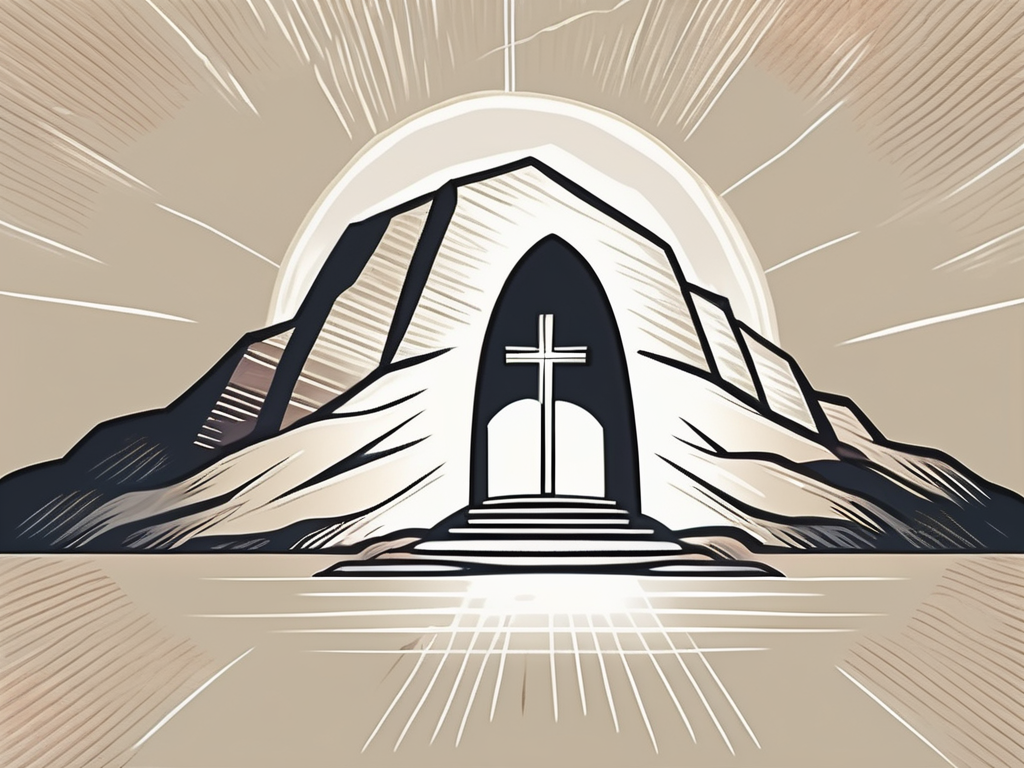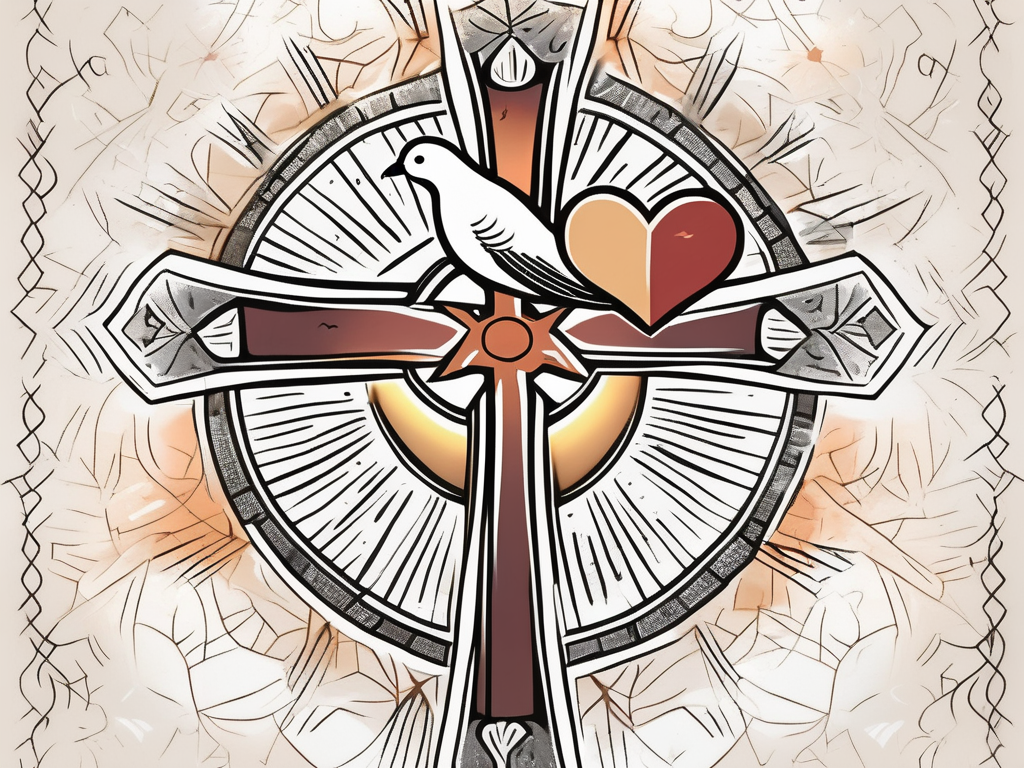The resurrection of Jesus Christ is a powerful and compelling story that lies at the heart of Christianity. As believers, it is important to understand the significance of resurrection in our faith and how it shapes our beliefs and practices. Let us delve into this fascinating topic and explore its theological perspectives, biblical account, interpretation, impact on early Christianity, and its relevance in contemporary Christian practices.
Understanding the Significance of Resurrection in Christianity
Resurrection holds immense significance within the Christian faith. It is not merely a historical event but a profound theological concept that conveys hope, redemption, and triumph over death. Resurrection represents the core belief that Jesus, who was crucified and buried, miraculously rose from the dead, conquering sin and death itself. This event serves as the ultimate validation of Jesus’ divinity and the fulfillment of Old Testament prophecies.
When we delve deeper into the significance of resurrection, we find that it goes beyond a simple narrative. It is a powerful symbol of transformation and renewal. Just as Jesus emerged from the tomb, Christians believe that they too can experience a spiritual rebirth. Resurrection is a reminder that no matter how broken or lost one may feel, there is always hope for a new beginning.
Theological Perspectives on Resurrection
Various theological perspectives exist concerning the resurrection of Jesus. Some theologians view it as a literal, bodily resurrection, highlighting the physicality of Jesus’ appearance to the disciples. They emphasize the wounds on his hands and feet, the tangible proof of his victory over death. This perspective underscores the miraculous nature of resurrection and the tangible evidence of Jesus’ triumph.
On the other hand, there are theologians who interpret resurrection symbolically. They focus on the spiritual implications of resurrection, such as the renewal of believers’ souls. For them, resurrection is not about a physical body rising from the dead, but rather a metaphorical representation of the transformative power of Jesus’ teachings. It is through his teachings and example that believers can experience a resurrection of their own, shedding their old selves and embracing a new life in Christ.
While these perspectives may differ, they all affirm the transformative power of Jesus’ resurrection in the Christian narrative. Whether one sees it as a physical or spiritual event, the resurrection remains a central tenet of the faith.
The Role of Resurrection in Christian Beliefs
Resurrection plays a central role in shaping Christian beliefs. It is the cornerstone of faith, for without it, Christianity would lose its foundation. The resurrection of Jesus affirms his identity as the Son of God and the savior of humanity. It is through his resurrection that the promise of salvation is fulfilled.
Moreover, the resurrection offers believers the assurance of eternal life and the hope of resurrected bodies in the future kingdom of God. It is a reminder that death is not the end, but a gateway to a glorious future. Christians find solace in the knowledge that through Christ’s resurrection, they too can have victory over death and experience eternal life in the presence of God.
Resurrection also holds a practical significance in the lives of believers. It serves as a source of inspiration and motivation to live a life worthy of the calling they have received. The resurrection of Jesus is a constant reminder that they are called to be transformed, to embody the love and grace that Jesus exemplified during his time on earth.
Furthermore, resurrection provides a lens through which Christians view suffering and hardship. It offers hope in times of despair, reminding believers that just as Jesus triumphed over death, they too can overcome the challenges they face. Resurrection instills resilience and perseverance, empowering believers to face adversity with unwavering faith.
In conclusion, the significance of resurrection in Christianity goes far beyond a historical event. It is a theological concept that embodies hope, redemption, and triumph. Whether seen as a literal or symbolic event, resurrection remains the cornerstone of the Christian faith, affirming Jesus’ divinity and offering believers the promise of eternal life. It is a reminder that through Christ, transformation and renewal are possible, and that in the face of suffering, there is always hope for a glorious future.
The Biblical Account of Jesus’ Resurrection
The Bible provides a detailed account of Jesus’ resurrection, chronicling the events leading up to this pivotal moment and the narratives recorded in the four Gospels – Matthew, Mark, Luke, and John.
The Events Leading up to the Resurrection
Prior to his crucifixion and resurrection, Jesus shared the Last Supper with his disciples, praying in the Garden of Gethsemane. This was a significant moment as Jesus knew that his time on earth was coming to an end. He gathered his closest followers, breaking bread and sharing wine, symbolizing his body and blood that would be sacrificed for the salvation of humanity.
After the Last Supper, Jesus was betrayed by one of his disciples, Judas Iscariot, who led a group of soldiers to arrest him. Jesus was then subjected to a series of trials, both religious and political, where he was accused of blasphemy and sedition. Despite being innocent, Jesus was sentenced to death by crucifixion, a brutal form of execution reserved for the worst criminals.
Following his sentencing, Jesus was brutally beaten, mocked, and forced to carry his own cross to the place of execution. The crucifixion took place on a hill called Golgotha, also known as the “Place of the Skull.” Jesus was nailed to the cross, and as he hung there, he endured unimaginable pain and suffering.
After Jesus’ death, his body was taken down from the cross and placed in a tomb. This tomb belonged to Joseph of Arimathea, a wealthy and influential follower of Jesus. The tomb was sealed with a large stone, and Roman soldiers were stationed outside to guard it. It seemed like the end of the story, but little did anyone know that something miraculous was about to happen.
The Resurrection as Narrated in the Four Gospels
Each Gospel presents a slightly different account of the actual resurrection. Matthew describes an earthquake and an angel descending from heaven to roll away the stone, revealing an empty tomb. The presence of the angel was a powerful symbol of God’s intervention and the victory over death. Mary Magdalene and other women who had come to the tomb encountered Jesus, who instructed them to inform the disciples of his resurrection. This encounter brought immense joy and hope to the women, who were witnesses to this incredible event.
In Mark’s Gospel, the women discover the empty tomb and encounter a young man dressed in white, who informs them of Jesus’ resurrection. This mysterious figure reassures the women that Jesus has risen and instructs them to share the good news with the disciples. The women, filled with awe and wonder, hurriedly spread the word, unable to contain their excitement.
Luke’s Gospel recounts how the women find the tomb empty and are visited by two angels, who remind them of Jesus’ resurrection. These angelic messengers not only confirmed the truth of Jesus’ resurrection but also reminded the women of the words Jesus had spoken to them during his ministry. Later, Jesus appears to two disciples on the road to Emmaus, revealing himself to them in a profound and transformative encounter. This encounter strengthens their faith and prepares them to share the news of Jesus’ resurrection.
In John’s Gospel, Mary Magdalene discovers the empty tomb and encounters Jesus, mistaking him for a gardener until he speaks her name. This deeply personal encounter between Jesus and Mary Magdalene highlights the intimate relationship Jesus had with his followers. It also demonstrates the power of recognizing Jesus not only through physical appearance but also through his voice and presence.
The resurrection of Jesus is a central event in Christian faith, representing victory over sin and death. The accounts in the four Gospels provide different perspectives and details, but they all converge on the essential truth that Jesus rose from the dead, bringing hope, redemption, and eternal life to all who believe in him.
Interpreting the Resurrection Story
The resurrection story is rich with symbolism, metaphors, and profound spiritual teachings. Exploring these interpretations can deepen our understanding and appreciation of this remarkable event.
When we delve into the symbolism and metaphors present throughout the resurrection narrative, we uncover a tapestry of significant spiritual truths. The empty tomb, for instance, goes beyond a mere physical absence; it represents the victory of life over death, a triumph that reverberates through the ages. As we contemplate the rolled-away stone, we recognize that it signifies more than just the removal of a physical barrier. It represents the breaking down of the walls that separate humanity from the divine, inviting us into a closer relationship with God.
One cannot ignore the profound impact of Jesus’ appearances to his disciples. These encounters serve as a powerful reminder of his ongoing presence in our lives. They illustrate that believers can have personal, transformative experiences with the risen Christ, encountering his love, grace, and wisdom in ways that shape their faith and understanding of the world.
However, the symbolism and metaphors in the resurrection story do not end there. They extend far beyond the surface level, reaching into the depths of our souls. The resurrection story symbolizes divine love, a love so immense and all-encompassing that it conquers even death itself. It symbolizes grace, the unmerited favor bestowed upon humanity, offering forgiveness and redemption. And it symbolizes the promise of eternal life, assuring us that death is not the end, but rather a transition into a new and glorious existence.
Modern Interpretations of the Resurrection
In addition to the traditional interpretations of the resurrection, modern theologians and scholars have contributed thought-provoking perspectives that challenge our understanding of this profound event. These interpretations invite us to explore the implications of the resurrection for social justice and liberation. They emphasize how Jesus’ victory over death compels believers to fight against oppression and work tirelessly for a more just society. The resurrection, in this context, becomes a call to action, a reminder that we are called to be agents of change, standing up for the marginalized and oppressed.
Furthermore, some contemporary scholars delve into the psychological and existential dimensions of the resurrection. They explore how this event can bring meaning and purpose to human existence. The resurrection becomes a symbol of hope, reminding us that even in the face of despair and uncertainty, there is a glimmer of light that can guide us forward. It offers a profound affirmation that life has meaning, that our actions matter, and that there is a greater purpose to our existence.
As we reflect on the resurrection story and its various interpretations, we are invited into a deeper engagement with our faith. We are encouraged to explore the layers of symbolism and metaphor, to wrestle with the profound spiritual truths they convey. The resurrection story is not a mere historical event; it is a living, breathing narrative that continues to shape and transform lives today.
The Impact of Jesus’ Resurrection on Early Christianity
The resurrection of Jesus had a profound impact on the early Christian movement, shaping its growth, theology, and witness to the world.
The Resurrection and the Growth of the Early Church
The belief in Jesus’ resurrection energized the early Church, prompting its rapid growth and the spread of Christianity. Early Christians saw themselves as witnesses to the resurrection, sharing their faith boldly, even in the face of persecution. This belief fueled their commitment to proclaim the gospel and establish communities of faith worldwide.
The Resurrection as a Catalyst for Christian Martyrdom
Early Christians regarded Jesus’ resurrection as the ultimate proof of his divinity and the truth of his teachings. This conviction led many believers to face martyrdom with unwavering faith, choosing death over renouncing their belief in the risen Christ. Martyrdom became a powerful testament to the transformative power and eternal hope found in the resurrection.
The Resurrection in Contemporary Christian Practices
The resurrection of Jesus continues to have a profound impact on contemporary Christian practices, influencing celebrations, liturgy, and worship.
The Resurrection and Easter Celebrations
Easter, the central event in the Christian calendar, commemorates the resurrection of Jesus. It is a joyous celebration of new life, redemption, and hope. Christians gather to worship, sing, and reflect on the significance of Jesus’ resurrection, often participating in traditions such as Easter egg hunts, symbolizing new life and rebirth.
The Resurrection in Christian Liturgy and Worship
The resurrection holds a prominent place in Christian liturgy and worship. It is celebrated through prayers, hymns, and readings that remind believers of the transformative power of Jesus’ victory over death. The Eucharist, or communion, often centers around Jesus’ resurrection, symbolizing the sharing of his life-giving body and blood with believers.
In conclusion, the resurrection of Jesus Christ is a biblical story that has come to life in the hearts and minds of believers throughout history. Its significance, as both a historical event and a theological concept, continues to shape Christian beliefs, practices, and identity. Understanding the biblical account, interpreting its symbolism, and reflecting on its impact can deepen our faith and appreciation for the resurrected Christ.












